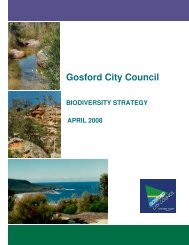Gosford City Council Historical Water Quality Review & Analysis
Gosford City Council Historical Water Quality Review & Analysis
Gosford City Council Historical Water Quality Review & Analysis
Create successful ePaper yourself
Turn your PDF publications into a flip-book with our unique Google optimized e-Paper software.
RESULTS OF WATER QUALITY DATA ANALYSIS 3-17<br />
Turbidity in Avoca Lagoon is also highly variable, with measurements up to 160 NTU. As discussed<br />
for the Koolewong site, turbidity records can be influenced by fouling of the probe, and there appears<br />
to be some evidence of this at Avoca Lagoon. Also, given its relatively shallow water, stirring of fine<br />
bed sediments during periods of lower water levels would also be a notable cause of elevated<br />
turbidity levels in Avoca Lagoon. Higher turbidity concentrations are observed during and flowing<br />
entrance breakout events, and also periods of catchment runoff (which do not result in entrance<br />
breakout).<br />
3.2.3 Cockrone Lagoon<br />
The Cockrone Lagoon entrance also broke out 14 times during the period March 1996 to Jun 2002,<br />
which included a period of 20 months (Sept 1999 to May 2001) when no breakouts occurred. The<br />
hydrology of Cockrone Lagoon is very similar to that described for Avoca Lagoon, with sudden<br />
responses to catchment runoff, gradual evaporation effects, and small periods of tidal influence<br />
following entrance breakout.<br />
The salinity of Cockrone Lagoon is variable, falling to levels of about 6ppt when the lagoon is ‘full’,<br />
and peaking at levels well in excess of oceanic salt concentrations (i.e. Hypersaline conditions)<br />
following breakout, recharge with ocean waters, and subsequent evaporation of ocean waters from the<br />
closed waterway.<br />
Temperature within Cockrone Lagoon varied on a seasonal basis, from approximately 25 – 30 °C in<br />
the summer to about 10 – 15 °C in the winter.<br />
pH levels generally ranged between 7 and 10. Similar to Avoca Lagoon, the pH levels in Cockrone<br />
Lagoon generally followed a seasonal trend, with higher levels during the later Autumn / early<br />
Summer months, and lower levels during the Autumn / Winter months. This trend was somewhat<br />
disrupted by the predominantly dry period of 2000 / 2001, which resulted in higher than expected pH<br />
levels for the majority of the time. pH is likely to be affected by the amount of primary productivity<br />
(photosynthesis) occurring within the water.<br />
Dissolved Oxygen (DO) in Cockrone Lagoon is highly variable ranging between 16 mg/L and zero.<br />
Although not completely evident, there appears to be a trend in DO concentrations that is also<br />
seasonal. Higher DO concentrations are recorded during the late autumn / early summer period,<br />
coinciding with the increase in primary productivity (as suggested by the higher pH levels). Lower<br />
DO levels occur during mid to late summer, extending through autumn. It is possible that the higher<br />
primary production rates in early summer are unsustainable, resulting in a massive die-off of the algae<br />
colonies. The decay (reduction) of this organic matter would generate a significant oxygen demand<br />
on the water column, thus depleting DO levels.<br />
Turbidity in Cockrone Lagoon is mostly less than about 10 NTU, however, some periods of heighten<br />
hydrologic activity result in significantly elevated turbidity levels (up to 160 NTU). Higher turbidity<br />
is recorded coinciding with catchment runoff events and entrance breakouts. However, there remains<br />
a considerable amount of data with higher turbidity concentrations that cannot be explained by such<br />
mass hydrologic processes.<br />
D:\R.N0754.002.01.DOC 7/11/03 16:11
















